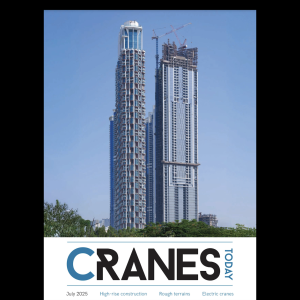The Karlastaden development by Serneke Group will cover 32,000sqm and ten city blocks. It will feature 2,000 apartments covering 200,000sqm condominiums, rental apartments, offices, shops, restaurants, a medical centre and school. In the centre of the district will stand the 245m, 73-storey Karlatornet skyscraper. Once finished, this will be the tallest in Scandinavia.
Construction activities throughout the development create a congested construction space for building the new skyscraper. That made the type of tower crane selection critical to ensure lifting efficiency without lines and jibs crossing each other’s paths or requiring one crane to wait for another to complete its lift.
Flens Byggmaskiner, with headquarters in Flens, was tasked with supplying the cranes for the high-rise project. Säfström initially used a Terex CTT 181 flat top tower crane to test the site for reach and capacity required over the project area. It was determined that two Terex CTL 430-24 and one Terex CTL 272-18 luffing jib tower cranes would offer the capacity and reach to cover the entire construction area.
Flens Byggmaskiner specially ordered the cranes from Terex’s Fontanafredda tower crane manufacturing facility in Italy for the Karlatornet project. “We loaded a total of 60 trucks for the roughly 1,800km trip to the project site,” said Bartosz Irzyniec, area sales manager for Terex tower cranes. “This included everything they needed for final crane configurations for this project: tower and jib segments, hoists, bases, counterweight, and cabins.”
It took roughly five days for the trucks to make it to Gothenburg, and Säfström staggered truck delivery of crane components over two days for efficient offloading. “There was limited space for unloading, and we had windy weather conditions for erection,” he says.
Once the components were unloaded, a team of five people for each crane immediately went to work assembling the cranes. “We had Terex technical sales representatives and service technicians on site to help our crew erect the cranes, and they have provided us with very good support,” said Dennis Säfström, operations manager for Flens Byggmaskiner.
The Terex CTL 430-24 luffing jib tower crane offers a maximum 60m jib length, a maximum lift capacity of 24t and maximum jib length lift capacity of 5.5t.
Crew members erected the first CTL 430-24 to a 63.4m tower height with a 50m jib. For the second crane, a hook height of 54.4m was required, and a 50m jib was installed. All three cranes, including the CTL 272-18, were mounted on anchor feet and equipped with low-temperature kits, service derricks and telematics for reporting critical operating data and fault codes, so issues could be quickly diagnosed and fixed.
If required at later stages of building construction, the Terex CTL 272-18 crane offers a maximum 61m jib length. Work crews equipped the crane with 50m of jib for the first tower construction phase. Initially, tower height was set to offer a 60.4m hook height. As construction progresses on the skyscraper, it will climb ultimately climb to deliver a 252.5m hook height to complete the 245m-tall structure.
“Above all, we use the cranes simultaneously in the same direction, and the luffing jib design allows this to happen without interference,” said Säfström. “Therefore, we save time and money and boost lifting operation efficiency because we do not have to wait for a crane that is in the way of another crane.”
The ability to work independently with the luffing jib design without fear of crane interference is a plus for Serneke Group’s builders as they work to stay on schedule for the construction timeline that will last into 2022. From tools and framing materials to concrete and elevators, all three cranes are tasked daily with making dozens of lifts for work crews.
“Depending on the load, the CTL 272-18 and CTL 430-24 offer hoist speeds reaching 230m/min and 160m/min respectively to quickly and safely lift and place the material,” said Irzyniec.






